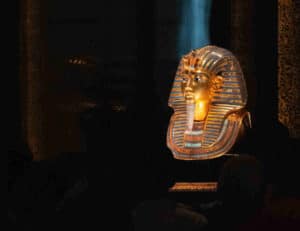The Valley of the Queens in Luxor does not enjoy the fame of the Valley of the Kings: that of Tutankhamun exemplifies that magnetism that is still held today for those tombs, among which others such as that of Seti I or Thutmose III also stand out. But the tombs of this necropolis (almost entirely female) have an
Getting to Know the Valley of the Queens
As its name suggests, the Valley of the Queens is the group of wadis where the tombs of the wives and daughters of the pharaohs were built, although in this space there are also some funerary spaces for men closely related to the pharaohs.
Its dating goes back mainly to the 19th and 20th dynasties (13th century BC), although there are also earlier funerary spaces, when burials in pyramids had been completely discarded: a more discreet and hidden space was preferable to avoid the spoilage and looting that was already occurring at that time.
Its location, like the Valley of the Kings, is on the west bank of Luxor (ancient Thebes), at a distance of 1 km in a straight line, but without direct communication by road or track. It is estimated that there are about a hundred funerary spaces, a number greater than that of the Valley of the Kings (something more than 60, approximately). To identify them correctly, the term QV (Queen’s Valley) followed by a number is used. However, the most popular are known by the name of the person who occupied it.
Two Outstanding Tombs of the Valley of the Queens
Despite the large number of tombs found in the Valley of the Queens, the vast majority have a great deterioration, the result of looting in the past by tomb robbers, but also because many of them were abandoned shortly after their construction began.
In fact, those that can be visited can be counted on the fingers of one hand. However, there are some outstanding exceptions to this, mainly two: the tomb of Tyti and the tomb of Nefertari.
The tomb of Tyti (QV52) was the first to be discovered, back in 1816. And it must have caused great admiration, as it is one of the most spectacular. Tyti was the daughter and wife of Ramses III, one of the most powerful pharaohs of the 19th dynasty. Under a ceiling of starry sky, walls protected behind glass can be seen, with reliefs that still retain some polychromy. In his scenes, numerous offerings to the gods starring Tyti herself.
The other great tomb of the Valley of the Queens is that of Nefertari (QV66), known for having been a demonstration of love from her husband, the pharaoh Ramses II, to his favorite queen. Everything here exudes beauty and youth, with a coloring so intense and alive that it even allows us to appreciate the intended transparency effects of her dress.
Information to Visit the Valley of the Queens
The visit to the Valley of the Queens takes place from 6:00 a.m. to 5:00 p.m. in the summer season, while during Ramadan and the winter season, the closing is brought forward to 4:00 p.m.
The general admission costs 220 EGP, with a 50% discount for students (110 EGP) and special prices for Egyptians and Arabs. In any case, we recommend that you check the situation of the site during your trip, as there may be tombs closed for conservation work, and the tomb of Nefertari may be subject to an additional ticket.



